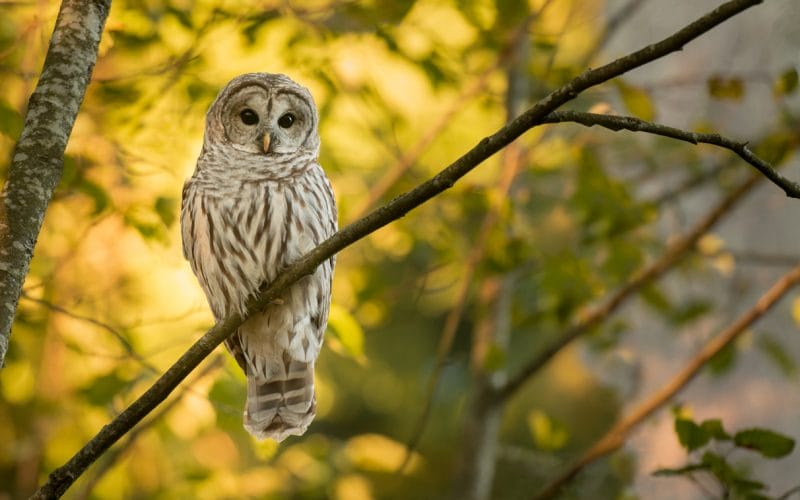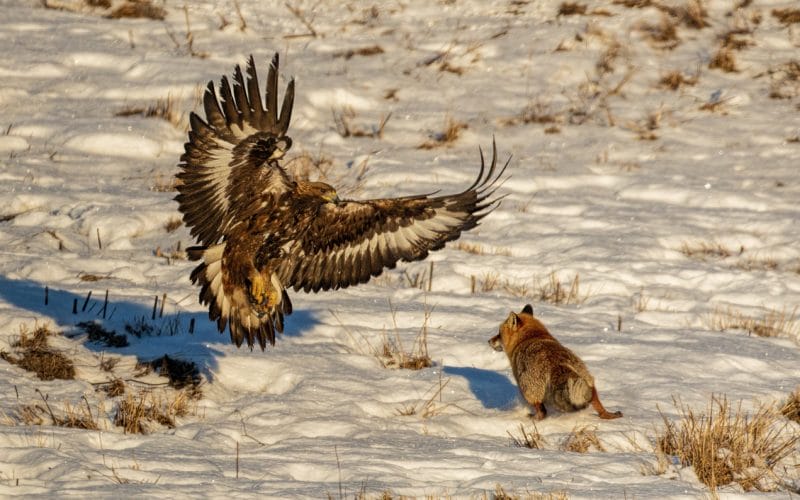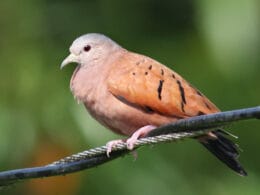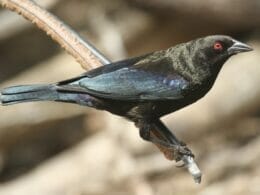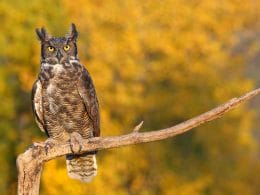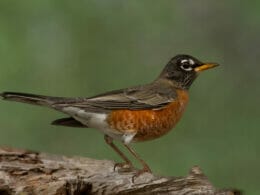From the highest plains in the west to the low wetlands in the southeastern borders of Oklahoma, there are 480 bird species that you can watch, study, and take photos of.
And if you’re interested in the majestic owls in Oklahoma, you have a chance to watch these fantastic nocturnal birds of prey.
In this article, we’ll highlight the famous owl species that you can watch in the Sooner State, so keep on reading to learn more about them.
10 Owls In Oklahoma that You Can See and Study
Owls can rotate their necks to a great extent while perching to watch their prey. As a result, these are the mighty hunters of the night. Here is some interesting information about the top 10 owls in Oklahoma.
1. Great Horned Owl

- Scientific name: Bubo virginianus
- Length: Between 17 and 25 inches
- Weight: Between 32 and 88 ounces
- Wingspan: Between 36 and 60 inches
Additional Information
The Great Horned Owls can be found in almost every part of Oklahoma, as long as there are rocky sites that provide the perfect spot for nesting. It’s the most common species of owls in Oklahoma.
These birds of prey have a mottled brownish-gray body and a face that looks slightly reddish. The owl gets its name from the earlike feathery tufts, which don’t allow the bird to hear anything but are used for camouflage or communication with other owls.
The Great Horned Owl is highly adaptable and can be found in several habitats. It feeds on animals and birds, including other owls; however, it can be the victim of mobbing by the American Crow.
Author Note: Although this owl prefers to hunt at dusk and before dawn, it might keep on hunting in the early morning and early evening when prey is scarce. In winter, this owl might also hunt during the day.
The Great Horned Owl is aggressive, territorial, and doesn’t mind killing members of its own species. And thanks to its strength, this fierce predator can take on larger predators like other raptors, including Ospreys, Prairie Falcons, and Peregrine Falcons. They use their powerful claws to cut the spine of the prey.
2. Short-eared Owl

- Scientific name: Asio flammeus
- Length: Between 13 and 17 inches
- Weight: Between 7.3 and 16.8 ounces
- Wingspan: Between 33 and 43 inches
Additional Information
Although most owls are nocturnal hunters, the Short-eared Owls are daytime hunters, when voles, their favorite prey, are active. They’re another common species owls in Oklahoma.
This medium-sized owl has a brown body with spotted buff and white underparts. It has yellow eyes, surrounded by black circles that make them stand out.
If you want to spot this owl, your best chance is to head to the open fields in Oklahoma at dusk or dawn. The Short-eared Owl can be found in airports, open fields, and meadows, and it prefers to hunt in low-light conditions, although it can be active during the hours of day and night.
It flies silently and usually close to the ground. It feeds on rodents after decapitating and eviscerating them.
When the female is forced to flush, it often defecates on the eggs to protect the nest. The resulting horrid smell helps mask the nest’s scent and even push predators away.
Male owls usually perform sky dances to attract the female and distract predators away from the nest.
3. Eastern Screech-Owl
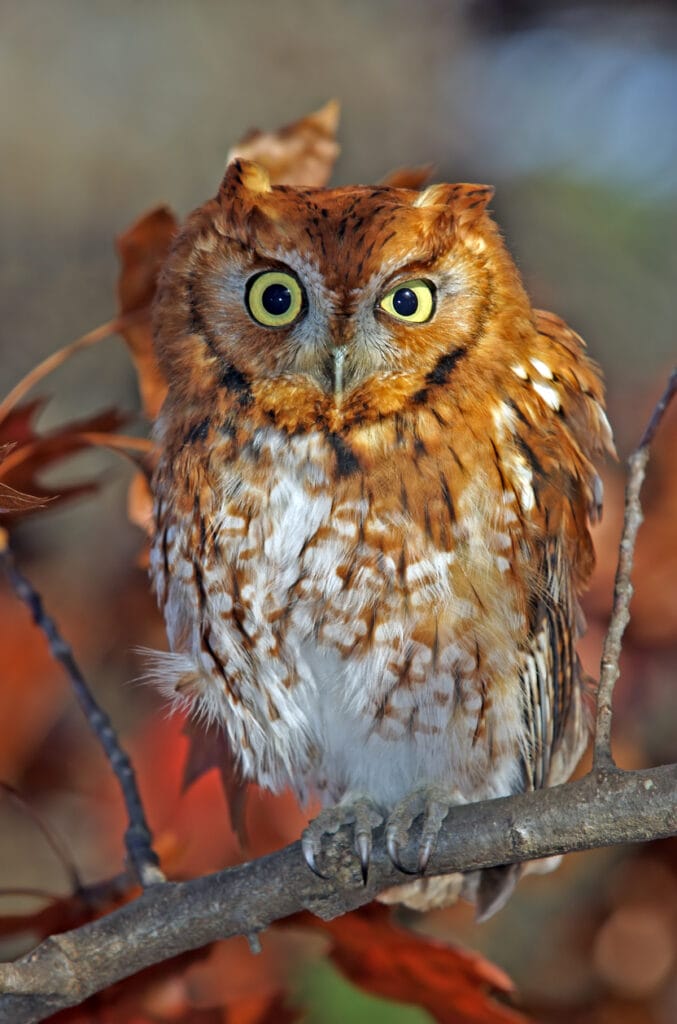
- Scientific name: Megascops asio
- Length: Between 6.3 and 9.8 inches
- Weight: Between 4.3 and 8.6 ounces
- Wingspan: Between 18 and 24 inches
Additional Information
The Eastern Screech-Owl can be found in every part of Oklahoma, except on the far western border. It has a reddish-gray plumage that provides the perfect camouflage when it’s roosting while hiding in tree nooks and crannies.
This owl has ear tufts that it uses for communication with other owls. At night, you can hear this owl hooting in wooded areas.
Top Tip: It can accept nesting boxes if you set one up before the breeding season. Pairs usually mate for life, and just like most owls, the males tend to be smaller than the females.
The Eastern Screech-Owl will stay away from larger owls like the Great Horned Owl, but it doesn’t mind nesting close to humans. It feeds on different types of rodents and birds, in addition to earthworms, lizards, and frogs.
Small songbirds can help you locate this bird, as they usually call each other to notify other birds of the owl’s presence. They fly around the owl and make noisy calls, which usually push the Eastern Screech-Owl away.
4. Western Screech-Owl
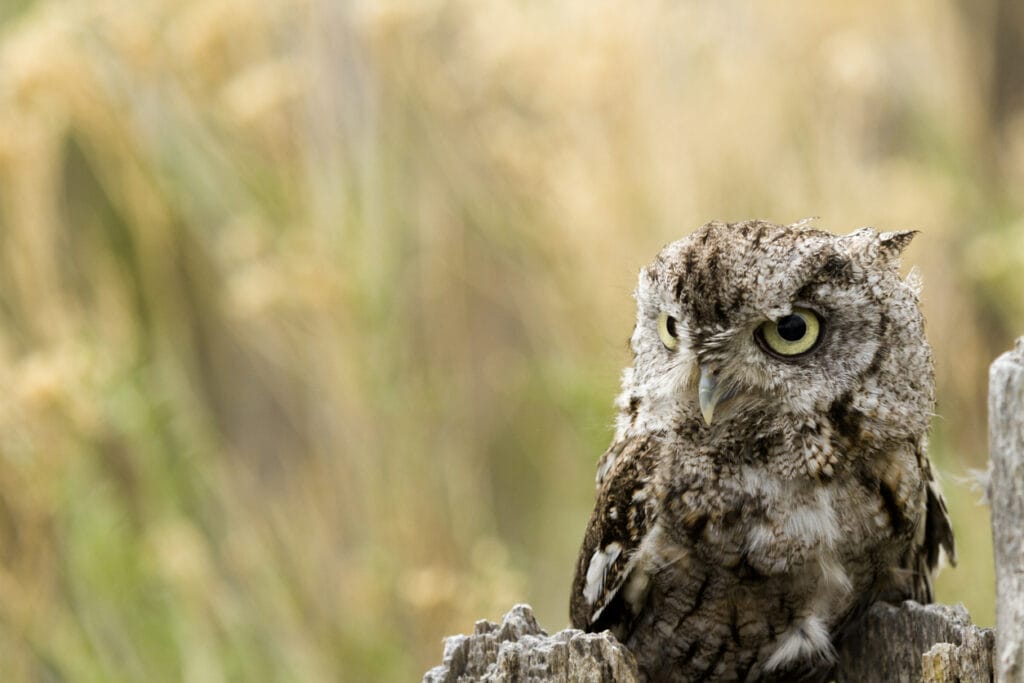
- Scientific name: Megascops kennicottii
- Length: About 8.7 inches
- Weight: About 5 ounces
- Wingspan: About 22 inches
Additional Information
The Western Screech-Owl can be found all year long in Oklahoma around farm fields, suburban areas, and water bodies. The owl has a small brownish or dark gray body that provides the perfect camouflage while the owl presses itself against the tree bark when it’s roosting, which makes it hard to find.
This owl has a diverse diet, so it can be seen feeding on rodents, small birds, invertebrates, and insects. Compared to other owls, this one doesn’t have a high-pitched call but rather a pleasant one that doesn’t startle people, despite the owl’s name.
It occasionally takes prey bigger than itself, like cottontail rabbits. This owl avoids areas where the Great Horned Owl is nesting.
Unlike the Eastern Screech-Owl, this one doesn’t really screech but makes a series of hollow calls. It can be seen roosting at the nest’s entrance, but it usually remains invisible because of its plumage.
5. American Barn Owl
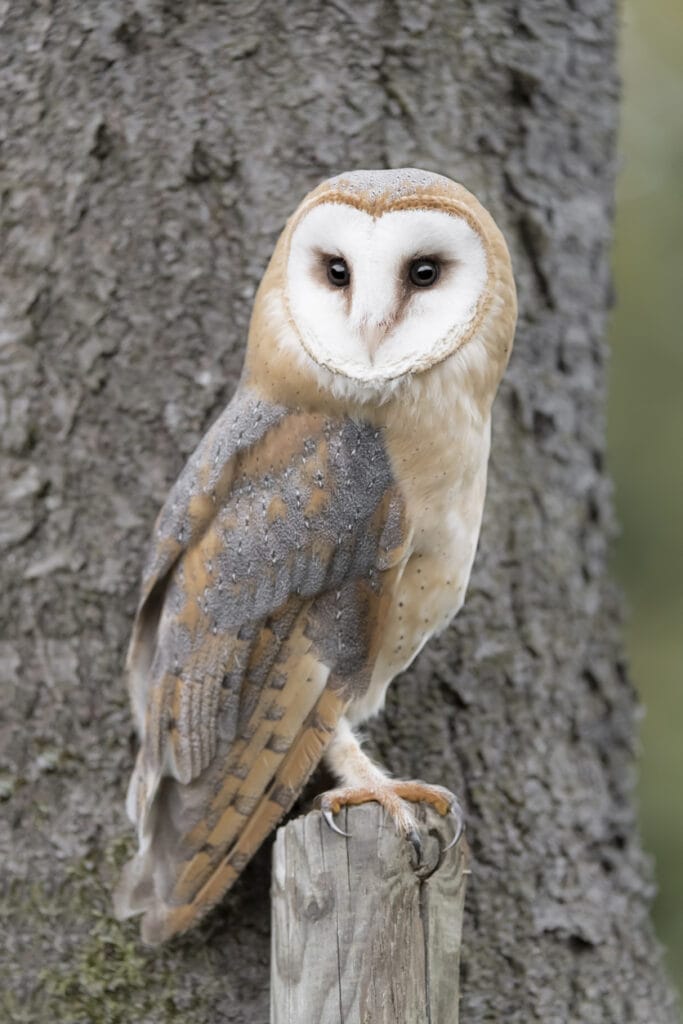
- Scientific name: Tyto alba
- Length: Between 13 and 15 inches
- Weight: Between 14.1 and 24.7 ounces
- Wingspan: Between 31 and 37 inches
Additional Information
The Barn Owl, also known as the Ghost or Church Owl, is found in different parts of Oklahoma, especially around the panhandle of the northwest region, which is dominated by short grass prairie, and in the southwest grasslands and mixed-grass plains.
There are 46 species of barn owls around the world, but the North American species is the biggest. This owl’s hoot is rather loud and can be a little irritating, especially when heard at a close range.
This is a medium-sized owl with gray and buff plumage and a sandy-colored heart-shaped face. Female owls tend to have more spots than males, and they happen to be more resistant to parasites. Moreover, it was noticed that male owls were more interested in helping these females, feeding their nestlings more often.
The shape of the face directs the sounds to the owl’s ears, which makes it one of the best hunters by sound. It prefers to roost in tree cavities and starts hunting during the first hours of the night.
The Barn Owl feeds on small mammals, but sometimes it feeds on birds. This owl swallows its prey as a whole and coughs out pellets that contain the bones, skin, feathers, and anything that doesn’t pass through the digestive tract.
6. Barred Owl

- Scientific name: Strix varia
- Length: Between 16 and 25 inches
- Weight: Between 16.6 and 37 ounces
- Wingspan: Between 38 and 49 inches
Additional Information
The Barred Owl can be found in different areas across Oklahoma with its distinctive hoot. If you set up a nesting box in your backyard, you might be able to attract a nesting pair as this owl prefers to nest in tree cavities.
Author Note: This owl has mottled brown plumage and big eyes to facilitate hunting at night. Its calls can be heard up to 0.5 miles away.
The Great Horned Owl represents the biggest threat to the Barred Owl. Although this owl doesn’t migrate and doesn’t like to move around, it will leave its territory if the Great Horned Owl is nearby.
The Barred Owl feeds on small rodents, birds, amphibians, invertebrates, and reptiles. It might also feed on fish, usually swallowing the head of the prey first and then the rest of the body. Younger owls are unable to fly, but they can climb tree trunks by grabbing the bark with their bills and talons.
Fossils of the Barred Owl that date back to 11,000 years ago have been dug up in several areas in Tennessee, Florida, and Ontario. Some owls can live up to 24 years.
7. Long-eared Owl
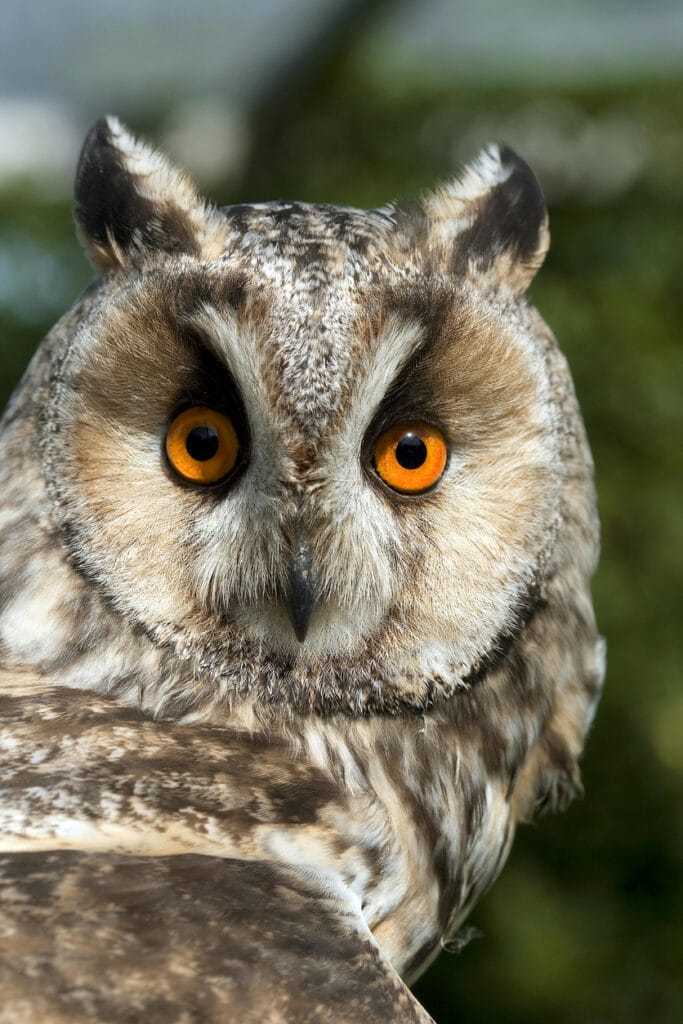
- Scientific name: Asio otus
- Length: Between 12 and 16 inches
- Weight: Between 7.8 and 15.3 ounces
- Wingspan: Between 34 and 40 inches
Additional Information
Also known as the Cat Owl, the Long-eared Owl is extremely difficult to spot in Oklahoma because of its perfect camouflage. It has a dark body with a brown or buff face and black ear tufts with orange fringes. The fringed feathers allow the owl to fly silently, so it remains undetectable.
You can find this owl in winter at night, where individuals roost in large numbers in the same area. The hoot of this owl can be heard up to a mile away, and it only accepts nesting in open-fronted nests and artificial baskets when set up by humans.
The Long-eared Owl catches its prey and bites the back of the head to kill it, and it usually feeds on rodents and birds. Just like most owls, the Long-eared Owl swallows its prey as a whole and then regurgitates the fur and bone remains in pellets.
Author Note: The asymmetrical ears improve the owl’s hearing, so it can precisely locate the prey’s location.
8. Snowy Owl

- Scientific name: Bubo scandiacus
- Length: Between 20 and 25 inches
- Weight: Between 46.4 to 88 ounces
- Wingspan: Between 46 and 65 inches
Additional Information
Also known as the Arctic Owl, the Snowy Owl is usually attracted to large lakes and open fields. It’s commonly seen in Oklahoma at Will Rogers Airport and around Lake Arcadia and Lake Overholser.
The snowy owl is the largest North American owl by weight, usually weighing the same or more than the Great Horned Owl. It’s characterized by having a pure white body with some black markings across the wings and back.
Its pale shape is accentuated by the bright cat-like yellow eyes, and it’s represented in some European cave paintings.
Male owls get whiter when they get older, while female owls retain their markings throughout their lives. To the untrained eye, this white owl might seem like a snowball when it’s on the ground.
The Snowy Owl perches on fences and telephone posts and usually flies close to the ground when it’s hunting. It feeds on rodents, rabbits, squirrels, weasels, birds, wading birds, and seabirds.
9. Burrowing Owl
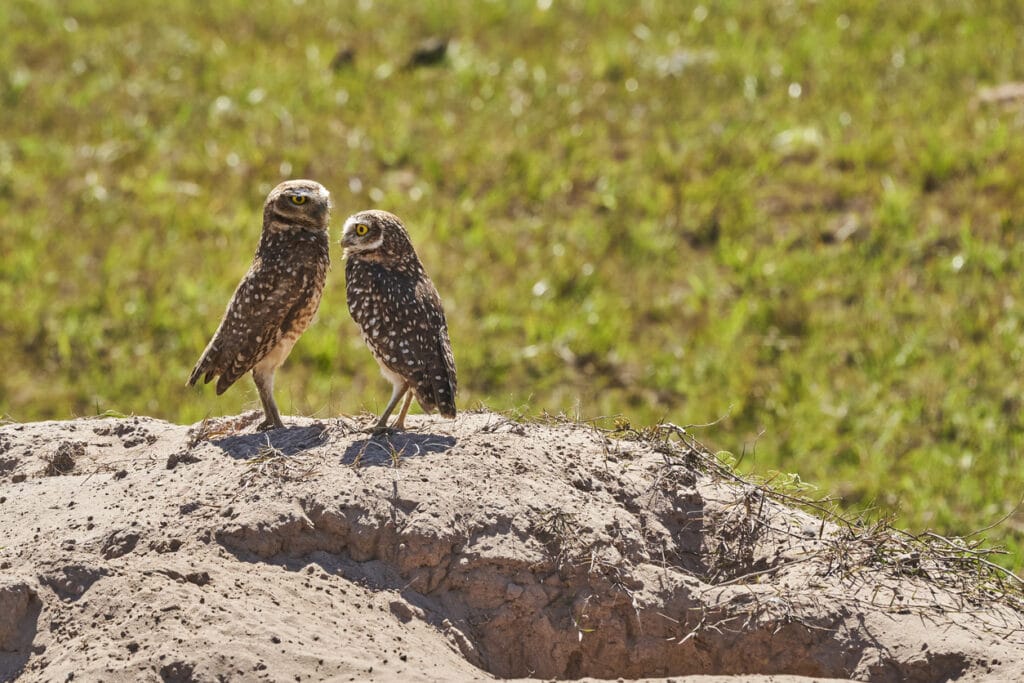
- Scientific name: Athene cunicularia
- Length: Between 7.5 and 11 inches
- Weight: Between 4.9 and 8.5 ounces
- Wingspan: Between 20 and 24 inches
Additional Information
The Burrowing Owl can be found in several spots in Central and Western Oklahoma during the breeding season. It’s a small sandy owl with bright yellow eyes and usually lives in burrows that it either digs by itself or borrows from the prairie dogs, tortoises, and ground squirrels.
Top Tip: The Burrowing Owl usually stores food in its burrows when it’s plentiful.
Although male owls are usually bigger than females, both sexes of the Burrowing Owl are of the same size. The Burrowing Owl can nest in PVC pipes when there are no burrows.
It flies close to the ground and spends most of its time on the ground. It can be found on dirt mounds around burrows, where it can be seen perching when it’s not hunting.
The Burrowing Owl feeds on small rodents and invertebrates, especially insects, which represent the owl’s favorite prey. It also feeds on birds and lizards. Although it’s crepuscular, female owls catch more insects during the day, while males prefer to catch mammals at night.
10. Northern Saw-Whet Owl

- Scientific name: Aegolius acadicus
- Length: Between 6.7 and 8.7 inches
- Weight: Between 1.9 and 5.3 ounces
- Wingspan: Between 16.5 and 22.2 inches
Additional Information
This is one of the smallest owls, and although rare to find, it can sometimes be spotted in Oklahoma if you’re lucky enough. The Northern Saw-Whet Owl has a small mottled brown body with a large whitish facial disk and a spotted head with no ear tufts.
It’s a nocturnal bird that hides all day, roosting in dense vegetation where it becomes hard to spot. However, the owl’s distinctive call will improve your chances of spotting it, as it sounds like a blade sharpened with a whetstone, which explains the owl’s name.
The Northern Saw-Whet Owl feeds on different types of mice and voles, in addition to chipmunks, squirrels, and gophers. It also supplements its diet with some birds and even other small owls.
If you live near a heavily wooded area, you might be able to attract a breeding pair of these owls to your backyard. Although pairs are usually monogamous, male owls have more than one mate when prey is abundant.
Several birds of prey, including the Great Horned Owl, Eastern Screech-Owl, and Cooper’s Hawks, target this owl. In addition, songbirds usually gather to push this owl away when it’s roosting.
Wrap Up
Owls are amazing creatures, and they attract the attention of everyone whether they’re into birdwatching or not.
Luckily, if you’re in Oklahoma, you’ve got a great chance of locating these magnificent birds of prey, especially at night, although some of them hunt by day. We hope you enjoyed our guide on the top owls in Oklahoma.
FAQ
According to Audubon, the following places are good to see a range of owl species: Red Slough Wildlife Management Area, Tishomingo National Wildlife Refuge, Mohawk Park, Tallgrass Prairie Preserve, Hackberry Flat Wildlife Management Area and Wichita Mountains Wildlife Refuge.
The Great Horned Owl and Short-eared Owl are the commonest owls in Oklahoma.
To find out where recent sightings of owls have been, try eBird. You can search for the latest sightings or particular species or what has been seen in a certain area.





